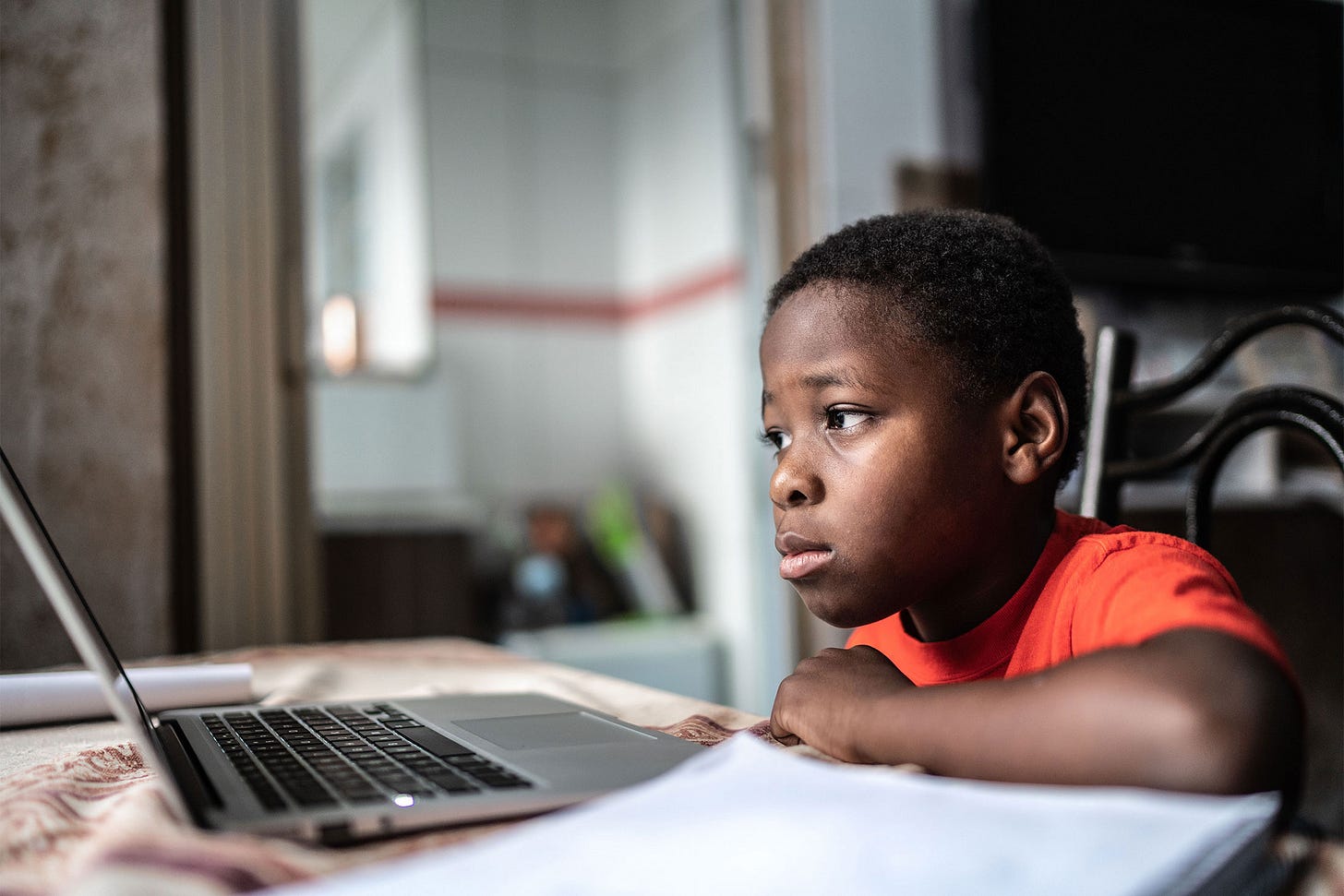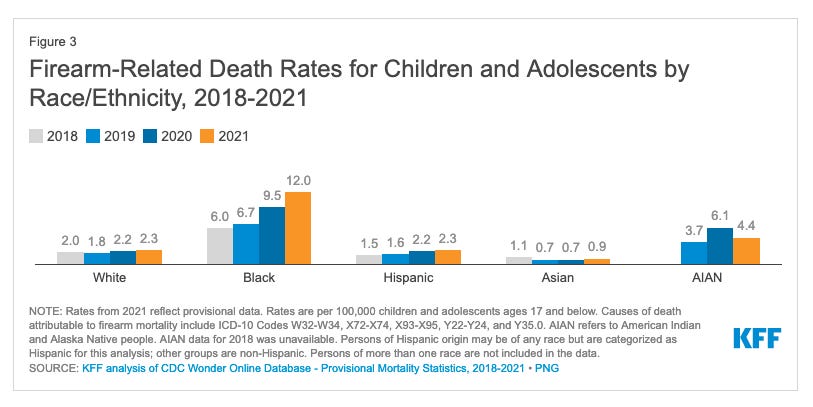Reimagining the Role of Technology in K-12 Education
Imagine if every Black student had the tools, the support, and the safety they need to make it in school and to make it in the world around them
Publisher’s Riff
Systems all around us are failing Black children: K-12 schools are the worst offenders. As astonishing is how we seem to tolerate it when we shouldn’t. Clearly, we can’t wait for these institutions to value our children’s lives as they do their own. Academically deprived and disinvested communities will need to come up a strategy for how we’re able to reverse these trends … more than likely on our own.
We’re already having trouble keeping Black children safe from public health calamities, such as the troublesome triple-demic (COVID, RSV, Flu) we’re now finding ourselves in. We certainly can’t keep them safe from racism, as a recent Journal of Osteopathic Medicine study shows …
We can’t keep them safe from gun violence, either, as a Kaiser Family Foundation analysis clearly indicates …
We’re also unable to keep them totally safe from the school to prison pipeline. We can’t really keep our children safe in places that are either unable to or refuse to protect them. We are regularly fighting a cause to ensure our children are provided the most basic tools and technology they need to participate, let alone succeed.
Technology can play a critical role in resolving all of the above. As we are re-imagining the role that technology can play in education, we should be considering virtual learning as a unique and much needed pocket of safety. We could have better re-imagined it as protection against public health threats. It could also be re-imagined as a path away from the school to prison pipeline. Or, how do we re-imagine it as a safe place away from racism and gun violence.
Getting there will entail communities imagining structured and successful virtual learning as opposed to failed remote learning. We should be clear on the difference.
Many of the same people who are refusing to protect us or refusing to allow us to protect ourselves and our families and our communities from racism, incarceration and increasing incidents of mass shootings in and outside our schools are also trying to convince us that virtual learning doesn’t work. That it hurts achievement levels or that it sets children behind.
But, that was remote learning. Not virtual learning.
Children didn’t suffer during the pandemic because virtual learning models didn’t serve them. They suffered because remote learning models were chosen over structured virtual learning models. Our children were never really offered expanded or organized virtual learning models through pandemic. Those models, which had been operating and refined for quite some time through expert virtual learning systems such as Stride Learning, worked rather well during what were viewed as the worst years of pandemic between 2020-2021. Those schools, according to Stride data, outperformed states in nearly 28 percent of literacy measures, while increasing reading proficiency by 63 percent - while states only increased by less than 12 percent. Meanwhile, Stride virtual learning schools outperformed states in 17 percent of math measures as they increased mathematics performance by 61 percent - as states only increased by 6 percent. We see similar outperformance rates compared to public schools in various states in science and social studies: while states increased performance measures by only 4 percent and zero percent in these subjects, respectively, Stride virtual learning schools increased their performance by 52 percent and 41 percent, respectively, in both.
Hence, it’s important that we’re crystal clear on the differences between actual structured learning and basic, unstructured and disorganized remote learning. Because the people working against us want you to imagine remote learning models when we talk about how we can re-imagine technology in education. They want you to accept a broken system that doesn’t work. They don’t want you to envision the safety and success and social mobility that is a standard with successful virtual learning models.
Broadband access had a lot to do with remote learning failure rates. According to research from Northeastern University, over 30 percent of the Black community still doesn’t have regular and reliable internet access. Mostly White and affluent administrators in school districts who decided to choose remote learning over virtual learning didn’t care about that. They chose to implement programs that only offered education to people with Internet access, computers, printers, paper, ink, and the education or support to solve technological problems. This was absolute mess.
One year into the pandemic, an upwards of 12 million students still did not have access to the Internet or devices adequate enough to engage in, once again, remote learning.
Reimagine what could have happened if our children were instantly offered free internet access, free state of the art technology and accessories, training on how to use it, and daily accessible – and friendly – tech support for both the students and the parents.
Imagine what that can do for whole families - and for us as Black communities subjected to disinvestment, distress and unnecessary struggle space. That’s what virtual learning models offer. That method has actually, and rather quietly, working at for over 20 years.
The pandemic didn’t just force Black families to navigate education outside of brick and mortar institutions. It also gave them the unique opportunity to exercise more autonomy and to steer their children away from institutions where they were facing increasing amounts of bullying, racism and as the tragedy in Uvalde, Texas (and more recently outside of public schools in Philadelphia) forces us to admit: Gun violence.
Black families across the nation are fighting to keep their children safe. That’s clearly reflected in the number that enrolled students in virtual learning programs. In April of 2020, for example, only 3 percent of Black households “home-schooled” their children. By October of that same year, that number increased more than five-fold to 16 percent. According to one survey of Black parents in Los Angeles Unified School District …
… 82 percent cited COVID-19 as one factor for keeping their children home and 43 percent said they were concerned about bullying, racism and low academic standards ….
From reporting last year (2021) in NPR …
In Texas, students have been assigned history textbooks that downplay slavery and avoid talking about Jim Crow. In Massachusetts, Black girls have been reprimanded for violating dress codes that ban hair extensions. And across the country, according to federal data, Black students are more likely than white classmates to be disciplined at school.
In Oregon, where Josh lives, Black students have lower graduation rates. They're also less likely to be identified as "talented and gifted."
All that can take a toll on kids. But for some students like Josh, remote learning during the pandemic has offered an escape.
To another 2021 feature in NPR …
In Black households, homeschooling can be its own unique form of activism and resistance.
"The history that's taught is that we've tried through Brown v. Board of Ed to get access to schools, and schools are integrated," said Cheryl Fields-Smith, a professor at the University of Georgia who studies Black homeschooling and its cultural significance.
"And that's true," she added. "But we've also always been self-taught."
Fields-Smith said homeschooling is a way to combat educational racism, which comes in many forms.
"We all know that there are structures and policies and practices within our traditional schools that can be damaging to students of color, Black students in particular," she said.
With NPR continuing to notice and acknowledge the trend in late 2022 …
The early part of the pandemic created an educational divide in the U.S. between parents who wanted their kids to stick with remote learning and parents who wanted their kids physically back in school. Over the last two years, more and more Black families have chosen to home-school their kids. Now, this trend did start before 2020, but the experience of remote learning at home led more families to make that leap.
When we reimagine the role that technology can play in the education system, we need to imagine a virtual shield specifically designed to protect Black children. Reimagine technology as a shield that not only protects our children from mass shootings, macro-aggressions, and microaggressions, but surrounds them with a team of people that are dedicated to supporting the wellness and well-being of each child. That’s what virtual learning does. Remote learning doesn’t do that, especially when it’s simply an extension of broken school systems to begin with.
The recommended number of school psychologists is 1 per 500 students. Only 8 percent of school districts in the nation met this standard. The number of counselors should be 1 to 250. These recommendations came before our children were subjected to a pandemic, the murder of George Floyd, insurrection and wave after wave of mass shootings.
And they wonder why many students didn’t achieve.
We don’t let our kids go through trauma after trauma without any help. Virtual learning models don’t make that mistake. Students and families are provided with overlapping networks of assistance that help students carry the weight of specialized personal needs, mental health needs, and general development. They have teams of experts and providers that are there to serve them as a whole person. That structured virtual learning model works.
Reimagine a nation where during the pandemic, they chose virtual learning over remote learning. They chose to use the pandemic as an opportunity to give families the technology and support they need to succeed in education and in society. Imagine a virtual learning environment that celebrated Black children for being themselves instead of punishing them. Imagine a space safe from microaggressions and macroaggressions … and gun violence. Imagine a virtual education system where students made gains in reading and in math as compared to national test scores during the pandemic. Imagine if every child, every Black child, had the tools, the support, and the safety they need to make it in school and to make it in this world.





